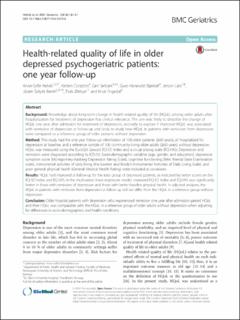| dc.contributor.author | Helvik, Anne-Sofie | |
| dc.contributor.author | Corazzini, Kirsten | |
| dc.contributor.author | Selbæk, Geir | |
| dc.contributor.author | Björklöf, Guro Hanevold | |
| dc.contributor.author | Laks, Jerson | |
| dc.contributor.author | Saltyte Benth, Jurate | |
| dc.contributor.author | Østbye, Truls | |
| dc.contributor.author | Engedal, Knut | |
| dc.coverage.spatial | Norway | en_US |
| dc.date.accessioned | 2020-08-04T13:27:58Z | |
| dc.date.available | 2020-08-04T13:27:58Z | |
| dc.date.created | 2016-07-11T13:25:25Z | |
| dc.date.issued | 2016 | |
| dc.identifier.citation | BMC Geriatrics. 2016, 16:131 (131), . | en_US |
| dc.identifier.issn | 1471-2318 | |
| dc.identifier.uri | https://hdl.handle.net/11250/2670821 | |
| dc.description.abstract | Background: Knowledge about long-term change in health related quality of life (HQoL) among older adults after hospitalization for treatment of depression has clinical relevance. The aim was firstly to describe the change of HQoL one year after admission for treatment of depression, secondly to explore if improved HQoL was associated with remission of depression at follow-up and lastly to study how HQoL in patients with remission from depression were compared to a reference group of older persons without depression.
Method: This study had the one year follow-up information of 108 older patients (≥60 years), all hospitalized for depression at baseline, and a reference sample of 106 community-living older adults (≥60 years) without depression. HQoL was measured using the EuroQol Group's EQ-5D Index and a visual analog scale (EQ-VAS). Depression and remission were diagnosed according to ICD-10. Socio-demographic variables (age, gender, and education), depressive symptom score (Montgomery-Aasberg Depression Rating Scale), cognitive functioning (Mini Mental State Examination scale), instrumental activities of daily living (the Lawton and Brody's Instrumental Activities of Daily Living Scale), and poor general physical health (General Medical Health Rating) were included as covariates.
Results: HQoL had improved at follow-up for the total group of depressed patients, as indicated by better scores on the EQ-5D Index and EQ-VAS. In the multivariate linear regression model, improved EQ-5D Index and EQ-VAS was significantly better in those with remission of depression and those with better baseline physical health. In adjusted analyses, the HQoL in patients with remission from depression at follow-up did not differ from the HQoL in a reference group without depression.
Conclusion: Older hospital patients with depression who experienced remission one year after admission gained HQoL and their HQoL was comparable with the HQoL in a reference group of older adults without depression when adjusting for differences in socio-demographics and health conditions. | en_US |
| dc.description.sponsorship | The data collection was funded by the participating Old Age Psychiatry Units in Norway. No funding was otherwise given for the present study. | en_US |
| dc.language.iso | eng | en_US |
| dc.relation.uri | http://download.springer.com/static/pdf/877/art%253A10.1186%252Fs12877-016-0310-6.pdf?originUrl=http%3A%2F%2Fbmcgeriatr.biomedcentral.com%2Farticle%2F10.1186%2Fs12877-016-0310-6&token2=exp=1485942641~ | |
| dc.rights | Navngivelse 4.0 Internasjonal | * |
| dc.rights.uri | http://creativecommons.org/licenses/by/4.0/deed.no | * |
| dc.subject | Activities of Daily Living Aged Cognition Depression | en_US |
| dc.subject | diagnosis Depression | en_US |
| dc.subject | epidemiology Depression | en_US |
| dc.subject | physiopathology Depression | en_US |
| dc.subject | psychology Female | en_US |
| dc.subject | Follow-Up Studies | en_US |
| dc.subject | Geriatric Assessment | en_US |
| dc.subject | methods | en_US |
| dc.subject | Geriatric Psychiatry | en_US |
| dc.subject | methods Hospitalization | en_US |
| dc.subject | statistics & numerical data | en_US |
| dc.subject | Humans Inpatients | en_US |
| dc.subject | Male Middle Aged | en_US |
| dc.subject | Norway | en_US |
| dc.subject | epidemiology Pain Measurement | en_US |
| dc.subject | methods Psychiatric | en_US |
| dc.subject | Status Rating Scales | en_US |
| dc.subject | Psychological Techniques | en_US |
| dc.subject | Quality of Life | en_US |
| dc.title | Health-related quality of life in older depressed psychogeriatric patients: one year follow-up | en_US |
| dc.type | Peer reviewed | en_US |
| dc.type | Journal article | en_US |
| dc.description.version | publishedVersion | en_US |
| dc.rights.holder | This article is distributed under the terms of the Creative Commons Attribution 4.0 International License (http://creativecommons.org/licenses/by/4.0/), which permits unrestricted use, distribution, and reproduction in any medium, provided you give appropriate credit to the original author(s) and the source, provide a link to the Creative Commons license, and indicate if changes were made. The Creative Commons Public Domain Dedication waiver (http://creativecommons.org/publicdomain/zero/1.0/) applies to the data made available in this article, unless otherwise stated. | en_US |
| dc.source.pagenumber | 9 | en_US |
| dc.source.volume | 16:131 | en_US |
| dc.source.journal | BMC Geriatrics | en_US |
| dc.source.issue | 131 | en_US |
| dc.identifier.doi | 10.1186/s12877-016-0310-6 | |
| dc.identifier.cristin | 1367449 | |
| cristin.ispublished | true | |
| cristin.fulltext | original | |
| cristin.qualitycode | 1 | |

